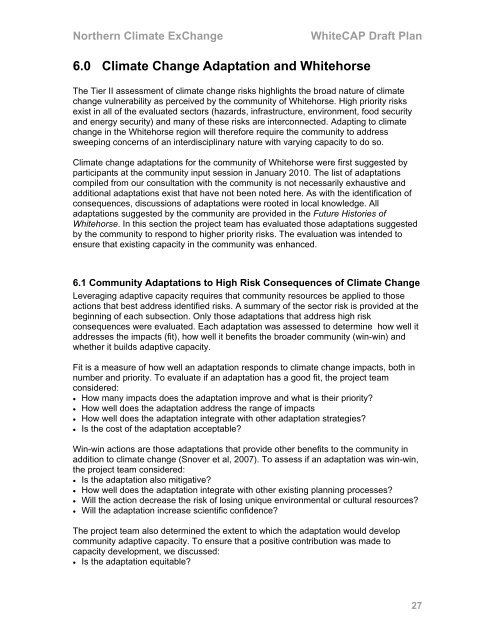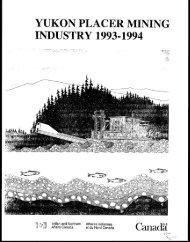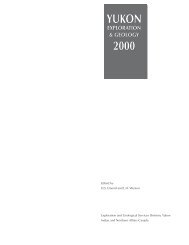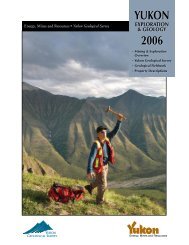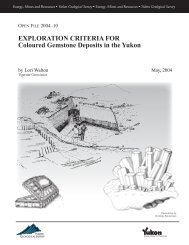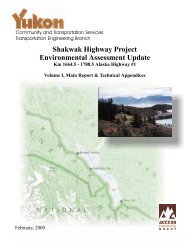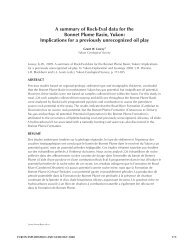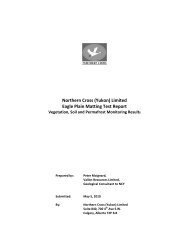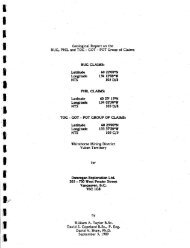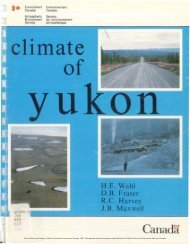WhiteCAP_Plan_01SEPT..
WhiteCAP_Plan_01SEPT..
WhiteCAP_Plan_01SEPT..
Create successful ePaper yourself
Turn your PDF publications into a flip-book with our unique Google optimized e-Paper software.
Northern Climate ExChange <strong>WhiteCAP</strong> Draft <strong>Plan</strong><br />
6.0 Climate Change Adaptation and Whitehorse<br />
The Tier II assessment of climate change risks highlights the broad nature of climate<br />
change vulnerability as perceived by the community of Whitehorse. High priority risks<br />
exist in all of the evaluated sectors (hazards, infrastructure, environment, food security<br />
and energy security) and many of these risks are interconnected. Adapting to climate<br />
change in the Whitehorse region will therefore require the community to address<br />
sweeping concerns of an interdisciplinary nature with varying capacity to do so.<br />
Climate change adaptations for the community of Whitehorse were first suggested by<br />
participants at the community input session in January 2010. The list of adaptations<br />
compiled from our consultation with the community is not necessarily exhaustive and<br />
additional adaptations exist that have not been noted here. As with the identification of<br />
consequences, discussions of adaptations were rooted in local knowledge. All<br />
adaptations suggested by the community are provided in the Future Histories of<br />
Whitehorse. In this section the project team has evaluated those adaptations suggested<br />
by the community to respond to higher priority risks. The evaluation was intended to<br />
ensure that existing capacity in the community was enhanced.<br />
6.1 Community Adaptations to High Risk Consequences of Climate Change<br />
Leveraging adaptive capacity requires that community resources be applied to those<br />
actions that best address identified risks. A summary of the sector risk is provided at the<br />
beginning of each subsection. Only those adaptations that address high risk<br />
consequences were evaluated. Each adaptation was assessed to determine how well it<br />
addresses the impacts (fit), how well it benefits the broader community (win-win) and<br />
whether it builds adaptive capacity.<br />
Fit is a measure of how well an adaptation responds to climate change impacts, both in<br />
number and priority. To evaluate if an adaptation has a good fit, the project team<br />
considered:<br />
• How many impacts does the adaptation improve and what is their priority?<br />
• How well does the adaptation address the range of impacts<br />
• How well does the adaptation integrate with other adaptation strategies?<br />
• Is the cost of the adaptation acceptable?<br />
Win-win actions are those adaptations that provide other benefits to the community in<br />
addition to climate change (Snover et al, 2007). To assess if an adaptation was win-win,<br />
the project team considered:<br />
• Is the adaptation also mitigative?<br />
• How well does the adaptation integrate with other existing planning processes?<br />
• Will the action decrease the risk of losing unique environmental or cultural resources?<br />
• Will the adaptation increase scientific confidence?<br />
The project team also determined the extent to which the adaptation would develop<br />
community adaptive capacity. To ensure that a positive contribution was made to<br />
capacity development, we discussed:<br />
• Is the adaptation equitable?<br />
27


